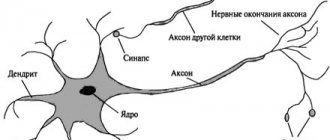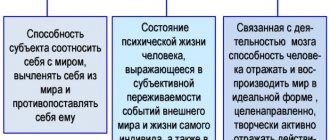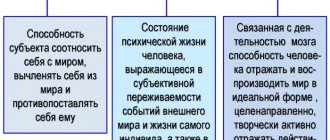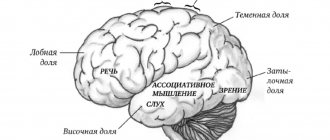Is human consciousness in psychology? Consciousness and the brain in brief! Properties of personality consciousness! Self-awareness, local focus, thought process, reflection, alter consciousness.
Hello, smart, energetic, curious readers !
Properties of consciousness
Consciousness is a reflection of objective reality in a person’s head. Each of us thinks in images that are born in the mind.
The higher the level of consciousness, the more a person is able to analyze his own actions and actions.
Consciousness allows a person to resort to deep reflection, think analytically and synthetically. A person with developed consciousness is always a person with high intelligence. The ability to analyze a situation and make responsible decisions characterizes a strong personality who knows how to admit even his own defeats.
The properties of consciousness are its significant characteristics that manifest themselves in the process of reflecting objects of the material world. Let's consider how these properties are expressed.
Forms and types
Consciousness in psychology is a dual concept that can mean such forms of consciousness as social and individual consciousness.
Social consciousness is the totality of knowledge, ideas and views inherent in a particular society or all of humanity at a certain stage of its development.
Structure of consciousness in psychology
Individual consciousness is the totality of knowledge, ideas and views of an individual.
Both forms of consciousness influence each other throughout their entire existence. As a result of this interaction, the development of both social and individual consciousness of all people occurs.
Depending on the degree of clarity of individual consciousness, several types are distinguished:
- Clear (when a person thinks actively, answers questions clearly and reacts adequately to surrounding events).
- Unclear (when a person shows indifference towards himself, and he answers the questions posed slowly and not always correctly).
- Stupor (if a person cannot independently navigate in space and reacts slowly to external stimuli).
- Dullness (if a person is almost always in hibernation, from which he can only be brought out for a short time).
- Coma (when a person is in deep sleep and does not react to anything).
- Delusion (when a person perceives reality in a distorted form and reacts inadequately to external events).
- Hallucinations (if a person experiences auditory or visual distortions of information perceived from outside).
Basic properties of personality consciousness
Activity
One of the main properties of consciousness can be considered activity. Every action that a person performs has a motive and purpose. No one acts thoughtlessly, obeying only a chaotic combination of circumstances. If the goal is desired, then the person is often ready to make even incredible efforts to achieve it. Consciousness controls human behavior and tries to calculate everything in such a way that it is most beneficial to the person himself. Our ability to predict a situation and see our own prospects is a merit of consciousness. Such a property as activity allows consciousness to remain in a working state constantly. Under what circumstances is a person ready to take active steps? In the case when he understands the need for the actions taken.
Dynamism
By dynamism we understand such an orientation towards an object or phenomenon of the surrounding reality, in which consciousness reveals the ability for continuous development. The property of dynamism is that a person’s attention is always changing. We are able to concentrate for the most part only on what is truly meaningful and interesting to us. Turning to some object evokes various emotions; we connect our feelings to what we hear and see around us, what we observe. This property of consciousness as dynamism is always aimed at immersing in the essence of the phenomenon or object in question.
Constant reflection
It must be said that the ability to analyze one’s own actions and actions is an integral and significant characteristic of consciousness. A property called “reflection” helps at the right moment to turn to the source of your “I”, your inner essence and talk with it as frankly as possible. In such internal dialogues, a person often discovers that he lived and acted incorrectly, and was inattentive to his loved ones. Constant reflection is a property of consciousness that allows for effective self-observation at different periods of life. A person almost always compares his present self with the way he was before. Such a property of consciousness as reflection makes it easy to do this. Consciousness itself is capable of expanding and expanding a person’s understanding of the world.
Values and motives
Another property of consciousness is its focus on internal sources of significance. We are talking about values for the sake of which specific actions are taken. Human consciousness is of a motivational and value-based nature. A person sometimes has to make incredible efforts on himself in order to be able to negotiate with his inner conscience. Values and motives set in motion his mental activity.
Thus, the properties of consciousness always reflect the essence of a particular personality, its internal nature and capabilities. Each person is completely individual and each has their own preferences.
Block 1. Consciousness. Introduction.
Well, what does consciousness have to do with it, you say, if you, guy, write books on negotiations, conduct trainings on negotiations, then why delve into such jungle, because this is a completely different topic, and also very complex, but on this “information walk” you can generally get lost, get lost and find yourself in front of the mysterious. And yet, my dear fellow traveler, with whom we are now in the same carriage, carrying us across the fields of life, I will touch a little on the most mysterious and incredibly interesting topic: THE CONSCIOUSNESS OF THE NEGOTITOR.
Let's put a bold exclamation mark right away! There is simply no single fundamental theory that explains consciousness at the current moment in time, and therefore my timid attempt to talk a little about the quality of the NEGOTITOR’S CONSCIOUSNESS is just an ardent desire to share with you, attentive and interested readers.
Article “Consciousness and the Quantum World”
Consciousness, its properties, characteristics
The psyche as a reflection of reality in the human brain is characterized by different levels.
The highest level of the psyche characteristic of a person forms consciousness.
Consciousness is the highest, integrating form of the psyche, the result of the socio-historical conditions for the formation of a person in work, with constant communication (using language) with other people.
Its first characteristic. Human consciousness includes a body of knowledge about the world around us. The structure of consciousness thus includes the most important cognitive processes: sensations and perceptions, memory, imagination and thinking.
With the help of sensations and perceptions, with the direct reflection of stimuli affecting the brain, a sensory picture of the world as it appears to a person at the moment is formed in the mind. Memory allows you to renew images of the past in the mind, imagination allows you to build figurative models of what is an object of needs, but is absent at the present time. Thinking ensures problem solving through the use of generalized knowledge.
The second characteristic of consciousness is the clear distinction enshrined in it between subject and object, i.e., that which belongs to a person’s “I” and his “not-I.” Man, who for the first time in the history of the organic world stood out from it and contrasted himself with his surroundings, continues to retain this opposition and difference in his consciousness. A person makes a conscious self-assessment of his actions and himself as a whole.
The third characteristic of consciousness is ensuring goal-setting human activity.
The functions of consciousness include the formation of goals for an activity, while its motives are formed and weighed, volitional decisions are made, the progress of actions is taken into account and the necessary adjustments are made to it, etc.
The fourth characteristic of consciousness is the inclusion of a certain attitude in its composition. The world of feelings inevitably enters a person’s consciousness, where complex objective and, above all, social relations in which a person is included are reflected. Emotional assessments of interpersonal relationships are represented in the human mind.
Basic functions of human consciousness
Reflective. Consciousness organizes cognitive processes (perception, representation, thinking), and also organizes memory.
Estimated. Consciousness takes part in the formation of some emotions and most feelings.
A person evaluates most events and himself at the level of consciousness.
Creative. Creativity is impossible without consciousness. Many voluntary types of imagination are organized at a conscious level: invention, artistic creativity.
Reflective. A type of consciousness is self-awareness - the process by which a person analyzes his thoughts and actions, observes himself, evaluates himself, etc.
Transformative. A person consciously defines most of his goals and outlines the path to achieving them.
Time-forming. Consciousness is responsible for the formation of a holistic temporal picture of the world, in which there is a memory of the past, awareness of the present and an idea of the future. This is how human consciousness differs from the psyche of animals.
Properties of consciousness:
Activity - Consciousness is associated with activity, with an active influence on the world around us.
Selective nature - Consciousness is not directed at the whole world as a whole, but only at certain of its objects (most often associated with some unrealized needs)
Generalization and abstraction - Consciousness does not operate with real objects and phenomena of the surrounding world, but with generalized and abstract concepts, devoid of some of the attributes of specific objects of reality.
Integrity - The consciousness of a mentally healthy person, as a rule, has integrity.
Main pathologies
Syncope is caused by insufficient supply of ozone to the brain, which is usually caused by the presence of disturbances in the functioning of the body.
Vagal loss of consciousness
Most often they develop with spasms that narrow the nutrient vessels or with a decrease in pressure, and does not depend on severe pathologies of an organic nature. Some of the least dangerous causes of syncope include the following:
- stress (painful sensations or their expectations, the appearance of blood, an uncontrollable state of fear up to panic attacks, nervous overstrain);
- reflexes: coughing, sneezing, pain during urine excretion, penetration of a foreign object into the throat, problems with bowel movements, serious exercise;
- vegetative-vascular pathologies that develop during panic attacks.
After this condition, all functions are fully restored, but severe fatigue and panic attacks may be present.
Cardiogenic causes
The main factor causing syncope in 25% of cases is heart disease. After loss of consciousness occurs, it is immediately necessary to undergo a thorough diagnosis, since if this is not done, then a serious illness can be overlooked.
Most often, the factor that provokes insufficient oxygen supply to the brain and the formation of syncope in diseases of a cardiogenic nature is a decrease in the number of blood during cardiac output (blood pushed into the aorta during one contraction). As a rule, syncope is formed due to serious illnesses caused by disturbances in the heart rhythm (arrhythmia or tachycardia is detected, in which the heart rate is more than 160 beats per minute).
Loss of consciousness of arrhythmic type
This kind of syncope is caused by the presence of the following pathologies:
- Paroxysmal tachycardia is a sharp increase in the number of myocardial contractions per minute (more than 150).
- Ari – characterized by a high probability of cardiac arrest. It is quite difficult to identify such a pathology, since by the time the cardiogram is performed, the paroxysm has already disappeared, and such a false diagnosis as physiological fainting can be made. This does not reduce the likelihood of death.
- Weakening of the sinus node (poor functioning of the central node that controls the rhythm of the heart).
- Atrial fibrillation and gastric fibrillation.
- SVC syndrome is characterized by a pathological path of impulse conduction in the myocardium.
With this kind of disease, rhythm problems arise and the saturation of brain cells with blood is interrupted.
Other reasons
Other causes of insufficient cardiac output include the following:
- problems with the functioning of the ventricles;
- a heart attack that provoked problems with muscle contraction;
- congenital or acquired defects of the heart structure;
- vascular thrombosis;
- atherosclerosis.
With prolonged weak functioning of the coronary vessels, ischemia is formed (cell death occurs). Atrophy of the active fibers of the heart is observed; they are replaced by connective tissue, which is characterized by increased density and is unable to contract. There is a decrease in the output volume, the brain cells do not have enough oxygen, which causes a loss of syncope.
Basic properties of consciousness
Within this property, internal conflicts of values or interests are possible.
Constancy - Relative stability, immutability and continuity of consciousness, determined by memory.
The constancy of consciousness is determined by the properties of the individual.
Dynamism - Its changeability and ability for continuous development, determined by short-term and rapidly changing mental processes that can be fixed in the state and in new personality traits.
Distortion - Consciousness always reflects reality in a distorted form (some of the information is lost, and the other part is distorted by individual characteristics of perception and personal attitudes)
Individual character - The consciousness of each person is different from the consciousness of other people.
This is due to a number of factors: genetic differences, upbringing conditions, life experience, social environment, etc.
Ability to reflect - Consciousness has the ability to introspect and self-evaluate, and can also imagine how other people evaluate it.
Palliative care in the last days of a person’s life
“Those whom we ourselves accompany in the last phase of life,
teach us that
that preparation for death is the best preparation for life itself.”
The death of a palliative patient is a natural outcome of a chronic disease. The doctor’s task is not to artificially prolong the dying process, but to preserve the quality of a person’s life until the very end. Doctors must relieve painful symptoms, provide the patient with high-quality, sensitive care, and also help his loved ones cope with the loss of a loved one.
The article was prepared based on materials from a webinar by Diana Sitnikova, head of the department at the Moscow Multidisciplinary Center for Palliative Care of the Department of Health.
Why don't we provide resuscitation to palliative patients?
Resuscitation measures for a palliative patient lead to an artificial prolongation of the dying process. There is also a legislative basis for this.
Federal Law No. 323-FZ of November 21, 2011 “On the fundamentals of protecting the health of citizens of the Russian Federation” states:
Resuscitation measures are not carried out: in a state of clinical death (stopping the vital functions of the human body (blood circulation and breathing) of a potentially irreversible nature in the absence of signs of brain death) and against the background of the progression of reliably established incurable diseases or incurable consequences of acute injury that are incompatible with life.
Resuscitation. Can she help? What you need to know about resuscitation and the condition of a person in the terminal stage of illness in order to make the right decision at the end of the life of a loved one Vera Foundation
Receiving palliative care
What are the terminal states?
- Predagonia;
- Terminal pause;
- Agony;
- Clinical death;
- Biological death (more about each of them below).
What the doctor needs to do:
- Adjust patient care - make it more gentle, abandon unnecessary manipulations;
- Remove unnecessary drainages, catheters, nasogastric tubes, etc.;
- Adjust therapy, discontinue medications that will not affect the quality and length of life;
Important It is necessary to continue pain relief with possible dose titration to achieve an adequate analgesic effect until the very end!
- Discuss his condition with the patient’s loved ones and explain what to expect.
Communication with the patient's loved ones
- Tell the patient's relatives what will happen to their loved one. Point out to them that what they perceive as torment is not always so for the patient.
- Give people time to accept the inevitability of loss as much as possible.
- Remind them that it is important to have time to resolve everyday, legal and civil issues: write a will, deeds of gift, etc.
- Help people spend time with a loved one: say something unsaid, finish something.
Spiritual testament: how to convey your experience to loved onesAbout the practice of writing letters in which a person can summarize his life, give parting words and share lessons with those who will remain after his passing The GroundSwell ProjectEnd of life
What can be done for the patient?
If a person is in a hospital, if possible, transfer him to a separate room and provide comfortable conditions. If the person is religious, offer to invite a clergy member and arrange for the visit if the patient agrees.
Organize an individual nursing station.
A person should not leave alone, even if he is already unconscious. One of the junior or nursing staff must be with the patient at all times.
Don't involve volunteers or interns in this - they may not be competent at this. The person nearby should have time to notice changes in the patient’s condition and inform the doctor about it in time.
Learn more about each phase of dying
Predagonia
Predagonia is characterized by severe circulatory and respiratory disorders, which lead to hypoxia. In the central nervous system at this moment, the process of inhibition predominates, the electrical activity of the cerebral cortex fades away.
Predagonia can last from 1 day to 1 month. The duration depends on the rate of progression of the underlying disease, the age of the patient and the initial resources of the body.
Symptoms of preagonia:
- Tendency to hypotension, hemodynamic disturbances;
- First tachycardia, tachypnea - then bradycardia and bradypnea;
- Progressive depression of the level of consciousness. From lucidity to coma;
- Increased hypoxia;
- If the patient is conscious, there is a gradual decrease in appetite;
- Oliguria, changes in the skin;
- Cyanosis, marbling of the skin;
- Hyperthermia.
Practical recommendations for the treatment of painful symptoms To help medical specialists, we have prepared practical recommendations for the treatment of the most common painful symptoms and conditions in palliative practice: nausea and vomiting, shortness of breath, constipation, itching, hiccups, anorexia and cachexia.
What should you do during this period?
First, hydration therapy (infusions or enteral nutrition) should be gradually reduced. If the life expectancy is several hours, stop completely. This should be done if the patient is already unconscious.
Important All actions must be coordinated with the patient’s relatives.
Continue symptomatic therapy - if there are any painful symptoms, including pain, continue to relieve them.
If the patient is at home, the question of hospitalization is raised in the following cases:
- If a person has pain or convulsive syndrome that cannot be controlled at home;
- Delirium requiring medical sedation;
- Obvious defects in care;
- If relatives are physically unable to care for a person in serious condition;
- If hospitalization is requested by the patient himself or his relatives who are not ready for the person to leave at home.
In this phase, we try to choose the least invasive method of administering drugs to the patient. Most often this is the buccal method. If the patient is still swallowing, tablet forms can be continued. The drugs can also be administered transdermally. You should switch to subcutaneous or intravenous injections only if necessary - with complete depression of consciousness and absence of swallowing. We try to avoid the intramuscular method, as it is the most painful.
Terminal pause
This phase is often difficult to identify. The terminal pause is characterized by:
- Sudden stoppage of breathing;
- Consciousness is completely absent;
- Peripheral reflexes are significantly reduced or completely absent;
- Muscle tone is minimal;
- A complete cessation of cardiac activity is possible.
Most often, the terminal pause ends in clinical death, bypassing all subsequent phases.
Agony
During this period, maximum activation of the body's resources to support life occurs. Against the background of pronounced inhibition of the cerebral cortex, strong excitation of the bulbar centers occurs.
The duration of agony depends on the type and mechanism of death, as well as on the adaptive capabilities of the body. It can last from several minutes to several hours, and sometimes be absent altogether.
Dr. Elisabeth Kübler-Ross. From the book “In the Middle of Life” The author of the concept of the five stages of grief, she saw the horrors of war, became a doctor at 31 and devoted her life to caring for the terminally ill Editors
About palliative care
Signs of agony:
- There is no consciousness;
- Terminal (agonal) breathing;
- Decreased pupillary response to light, no pharyngeal or corneal reflex;
- Muscle tone is reduced, but there may be decerebrate muscle rigidity;
- Convulsions;
- Hyperthermia or hypothermia;
- Hemodynamic disturbances;
- The pulse can only be felt in the carotid arteries;
- Discharge of biological vomiting and discharge of feces and urine;
- Tendon reflexes are absent;
- Maximum activation of the body’s vital forces is possible (this happens rarely);
- Lazarus syndrome, when flexion movements appear in the trunk and limbs, and the patient seems to sit down, raising his hands to his face - the so-called “boxer pose” (this happens extremely rarely).
At the end of the agony, manifestations of neuro-reflex activity completely disappear.
What should you do during this period?
Continue taking opioid analgesics. However, if the patient is unconscious, if there are no signs of pain and, in all likelihood, the end of life is a matter of minutes, then all interventions should be stopped. The same applies to positioning a person in bed - there is no need to turn him. The risk of developing bedsores is no longer important.
Important There should be a minimum of interventions at this stage! We leave only moisturizing of the mucous membranes, oral cavity, lips, conjunctiva.
Clinical death
The main signs of clinical death:
- Lack of consciousness;
- Lack of spontaneous breathing;
- Absence of pulse in the main arteries;
- Wide pupils;
- Lack of pupillary response to light and corneal reflex;
- Paleness, cyanosis of the skin.
Biological death
It is characterized by irreversible changes in all organs and systems that are permanent, cadaveric in nature.
A morgue is a civilized place. An interview with forensic expert Olga Fateeva about how a morgue works, what happens to a person’s body after death, why the deceased may be completely different from his living self, and whether embalming is always necessary Evgeniya Rezvan
End of life
Features:
- Early - drying and clouding of the cornea, a symptom of "cat's eye".
- Late - cadaveric spots and rigor mortis.
Practical advice
After declaring death, the doctor’s diary must indicate:
- – pallor and cyanosis of the skin;
- – lack of consciousness;
- – lack of breathing;
- – absence of pulse;
- – lack of reaction of the pupils to light;
- – absence of corneal reflex.
The exact date and time of death is also indicated.
What to do with painful symptoms in terminal conditions
Asthenization
Make sure the person is in a comfortable position in bed. Turn and move it less. You can massage before and after turns, especially in problem areas (such as bony prominences).
Important:
do not force the patient to do more than he wants or is able to do. Turns every two hours are no longer relevant. Absorbent underwear should be changed only when necessary: if the patient does not urinate, then there is no need to do this.
Depressed level of consciousness
The depression of consciousness can be gradual or, conversely, abrupt. May begin with increased sleepiness and difficulty waking up. The patient may have no initial reactions to verbal and tactile stimuli. Speech function deteriorates: the patient finds it increasingly difficult to find words, he gives monosyllabic, slow, sometimes inadequate answers, which he thinks about for a long time. Speech may also be completely absent.
What to do?
- Even if it seems that the patient does not hear or understand the spoken speech, you still need to warn about all your actions, speak calmly and quietly, and do not rush into answers.
- If the person does not seem to recognize anyone, we still talk to him as if he were a capable person.
- Continue pain therapy if we are 100% sure that it is not the cause of depression of consciousness.
- If the patient is unconscious, do not discuss the diagnosis or prognosis in front of him. Also don't do it if he doesn't want to talk about it.
- Do not talk about the patient in the third person.
- Avoid excessive activation, do not disturb the person, giving time to rest.
Palliative sedation: regulatory, ethical and clinical aspectsWhen is palliative sedation needed, is it necessary to obtain the patient’s consent and what moral problems will one have to face Diana Nevzorova Tatyana GremyakovaPain management at the end of life
What do relatives often ask?
Question: Why does he sleep all the time?
Variant answer: The patient does not have the strength to talk or stay awake due to increasing intoxication. If you imagine very severe poisoning, multiplied by a hundred times, this is what your relative is experiencing now. All the forces of his body are aimed at maintaining the central functions of the body: breathing, heart function. Sleep is a defensive reaction.
Question: Is it from the drugs you give him?
Possible answer: If this were a side effect of narcotic analgesics, it would appear during the initial intake or after increasing the dose. If this does not happen, then most likely the patient’s condition is associated with the manifestation of the underlying disease.
Hemodynamic disorders
Tachycardia, hypertension followed by hypotension, peripheral cooling, cyanosis, marbling of the skin.
What to do?
- If the patient feels weak due to a decrease in blood pressure, administer glucocorticosteroids (if there are no contraindications).
- Warm with a heating pad, always wrapped in a cloth or towel.
- Give a light massage if you feel chilly.
Under no circumstances should you carry out massive infusion therapy or administer vasopressors, as this is an artificial prolongation of life!
What do relatives often ask?
Question: Why are my hands and feet cold and cyanotic?
Variant answer: There is a redistribution of blood flow and centralization of blood circulation: the main blood flow is directed to the heart and brain, and less blood flows to the periphery (to the legs and arms).
Question: Why don’t you increase your blood pressure with medications?
Variant answer: At the moment, a decrease in blood pressure does not lead to worsening of the condition and death, but is a sign that the person is leaving. If we increase the pressure, we will artificially prolong his agony and, most importantly, his suffering.
Terminal breathing
There are several types of terminal breathing. The most common are those associated with an imbalance between excitation and inhibition in the central nervous system. The most common: Cheyne-Stokes, Biot, Grock or Kussmaul breathing.
What can you do about it?
- Give the person a comfortable position. Typically this means raising the head end of the bed.
- Continue to care for your oral cavity - moisturize the mucous membranes. With pathological breathing, the mouth is open, which means the mucous membranes dry out.
- Continue with previously prescribed opioid analgesics. Perhaps with dose titration.
- If you have previously started low-flow oxygen therapy, you can continue it. Under no circumstances stop it in the presence of relatives! Only if we could convince them that this was no longer necessary.
Death rattle
This painful symptom often worries the patient’s loved ones. It no longer bothers the person himself. It can be combated by administering moderate doses of M-anticholinergic drugs, for example, atropine. Or simply by turning the patient's head to the side. Mechanical ventilation should not be prescribed unless it has already been started (except in patients with ALS).
Palliative care for patients with ALS Breathing and swallowing disorders, communication difficulties and other symptoms in amyotrophic lateral sclerosis Vadim Parshikov
Symptomatic treatment
What do relatives often ask?
Question: Why did breathing change?
Variant answer: Our breathing is regulated by the respiratory center, which is now in a state of hypoxia. This can cause breathing to become irregular. This is a natural process.
Question: Why does the patient wheeze? Perhaps he is suffocating?
Variant answer: The sound is associated with impaired evacuation of bronchopulmonary secretions. The person cannot cough it up, and it seems that he is choking. This is not so: in fact, the person does not feel it, and he does not have the need to clear his throat.
Question: Do something, he’s suffering!
Variant answer: We understand how difficult it is to look at a loved one in such a state, but, believe me, the person himself no longer experiences suffering.
Lack of appetite and gradual decrease in fluid intake
What can be done?
- Give the patient small, frequent sips of water.
- If this is not possible, or the patient refuses by clenching his teeth (sometimes this is the only way for a person to show that he does not want to do this), try to irrigate the oral cavity with water or special gels such as artificial saliva.
- If, on the contrary, a person wants to eat, clarify his taste preferences. Someone wants champagne, someone wants red caviar - on their deathbed, everything is possible.
- When fluid intake is reduced, subcutaneous administration of saline is an option. We are always afraid of dehydration, since this can cause a deterioration of the condition - depression of consciousness, the development of delirium, constipation, etc.
Important: Do not force feed the patient under any circumstances!
Parenteral and enteral nutrition is contraindicated for patients in terminal conditions. This will not help anything and will not prolong life.
A nasogastric tube is placed if the prognosis for survival is several weeks. Installation of a gastrostomy tube is indicated if the life expectancy is at least 6 months.
Nasogastric tube: placement, feeding rules, prevention of complications Technique for placing the tube, possible complications and their prevention Varvara Brusnitsyna
Symptomatic treatment
What do relatives often ask?
Question: A person is dying of hunger, why does he refuse food?
Possible answer: Loss of appetite at this stage is normal and natural. All body functions are slowed down, so less energy is needed. The man is not hungry. If he wanted, he would eat. We cannot force him.
Question: Why is enteral nutrition not prescribed?
Variant answer: The body no longer has the energy resources to digest and assimilate food, the gastrointestinal tract is not able to extract nutrients. Blood circulation is aimed only at maintaining the functioning of the heart and brain. Enteral nutrition in this phase will not give anything.
Pain management at the end of life
- Continue pain management based on the severity of the person's condition. Opioids should not be discontinued if confusion or unconsciousness occurs. Rate pain using the PAINAD scale.
- If the patient can no longer speak, assess his pain behavior.
- If there is no swallowing, the patient should be switched to injectable forms of analgesics in an equivalent dosage.
Important In a number of patients in the terminal phase, pain becomes refractory and cannot be effectively treated. In this case, opioids are used in invasive forms in the form of prolonged subcutaneous or intravenous infusion. Their use is possible only in a hospital setting.
In some cases, with refractory pain, additional drug sedation is possible.
Delirium, agitation, increased anxiety
First, find out the cause of the agitation. It may be associated with unmet physical needs - unrelieved pain, bladder or bowel fullness.
If it is not possible to find out, the patient should be preventively anesthetized. That is, exclude pain as a possible cause.
It is necessary to show the patient that the doctor is his ally. Speak calmly and confidently. Do not object or argue with the patient. If this does not help, you should resort to drug treatment: haloperidol intramuscularly, if this does not help, aminazine.
Confusion, disorientation, anxiety - how to help? Sometimes terminally ill patients become agitated, cannot calm down, can get confused in time and space, and see people and things that are not there. What can be done for them? Vera Foundation
End of life
What do relatives often ask?
Question: Can a person in such a state harm himself?
Variant answer: In this condition the patient is already too weak. Most likely, he simply does not have enough strength for this. In addition, we will not allow him to be left alone, and we will install an individual nursing station in the ward.
Question: Why is this happening, why does he behave this way?
Variant answer: This condition is not a manifestation of a mental illness, but a consequence of dysfunction of internal organs, endogenous intoxication.
Question: Can he be calmed down?
Possible answer: Yes, but the patient may become drowsy and difficult to contact.
Ethical and psychological aspects of accompanying the patient and his family in the last hours of life
What should the doctor do before the patient reaches a terminal condition?
- Understand which of your loved ones will be with the patient and will participate in decision-making.
- Assess the extent to which the patient himself is aware of the approach of death: his speech and communication characteristics should be taken into account.
- Find out what the patient wants to know about his diagnosis and life prognosis. Ideally, find out where the person wants to die. There are people who fundamentally want to die at home. It is better to know about this in advance in order to provide transportation, painkillers, and organize visits from the patronage service - that is, arrange hospice at home.
By the way, the British palliative care doctor Bruce Cleminson said that information about the diagnosis belongs, first of all, to the patient. Read it!
In the last hours of a person’s life, his loved ones also need help. Talk to them, explain in advance what they can expect, discuss their fears and concerns.
After a person's death, their loved ones still need help. After all, this is only the beginning of their grief journey. In the Palliative Care Center of the Moscow Health Department, we can offer a consultation with a psychologist and provide the necessary literature. Usually people are confused, they need to clearly explain further actions, because they still have a lot of work to do.
After pronouncing death
- Notify a relative of the death if they were not present.
- Offer a farewell in a comfortable, private setting - only if the relative wants it (some people don’t want this on principle, because it’s morally difficult for them). Explain that there will be an opportunity to say goodbye at the morgue.
- Get ready to have to explain everything to your relatives several times.
- Provide relatives with information brochures to help them understand their next steps.
- Try to complete the documentation quickly. This determines how soon the body will be sent to the morgue and the funeral will take place. This can be very important for the patient's loved ones.
The material was prepared using a grant from the President of the Russian Federation provided by the Presidential Grants Foundation.
Stock image used from Depositphotos.
Properties of consciousness
The term “consciousness” (co-knowledge) is currently a generalization that suggests itself based on the development of philosophy, anthropology, psychology and other areas of knowledge in the humanities and natural sciences, can be understood as the highest level of mental reflection and joint action.
Some naive anthropocentrists believe that such a level of development is possible only among representatives of human society. Meanwhile, scientists more familiar with the natural sciences would not say so.
In its most general form, from a systemic-pragmatic point of view, consciousness is a set of permanently changing sensations, sensory and mental images that appear before the inner gaze of a conscious subject and predetermine his practical and mental activity.
The properties of consciousness are studied in some branches of psychology, as well as in other areas of knowledge.
Levels of Consciousness
In the process of human evolution, his consciousness also develops. A person’s attitude towards people and the world around him directly depends on the degree of development of his consciousness. As a result of many years of research into human consciousness, the famous psychologist David Hawkins identified 18 levels at which a person’s consciousness can be located, and each of these levels determines the degree of development of a person’s consciousness.
- Despair and shame (when a person, being a fool and making many mistakes because of this, often becomes depressed and hates everything around him, including himself).
- Feelings of guilt (when a person cannot forgive himself for past negative actions).
- Apathy (when a person loses interest in life, as a result of which he avoids any responsibility and may fall into dependent relationships).
- Grief (if a person falls into a state of constant regret and depression as a result of any failures or losses in life).
- Fear (when a person perceives the surrounding reality as too dangerous, resulting in a suppression of interest in life).
- Desires (if a person considers the meaning of life to be the satisfaction of his passions and excessively strives for material wealth).
- Anger (this state of consciousness arises from dissatisfaction with the desires of the previous level, as a result of which such a person can constantly be irritated and quarrel with others).
- Pride (this state of consciousness occurs when some success is achieved, as a result of which a person excessively increases his self-esteem and begins to divide people into friends and foes, thinking that he is superior to others).
- Courage (when a person has the courage and determination to overcome obstacles on the way to achieve new successes).
- Neutrality (when a person gains moral independence from other people and external circumstances, as a result of which he begins to be loyal to the people and events around him, even if they somehow try to influence him).
- Willingness (when a person’s goal is not material wealth, but the development of internal harmony, will and discipline, as a result of which a person becomes more sincere and friendly).
- Acceptance (a person’s awareness that the source of happiness and love is within himself, as a result of which a person stops demanding or expecting anything from others, and he himself begins to give people positive emotions, and stops judging others).
- Intelligence (when a person begins life primarily with the mind, and emotions take a back seat).
- Love (when a person realizes that love is higher than reason, as a result a person begins to act not from logical reasoning, but from a sincere state of love).
- Joy and unconditional love (when a person's love expands to an all-encompassing love for the world, nature and all people).
- Harmony, bliss (when a person is in a state of unity with the world and the boundaries between subject and object are erased, as a result of which a person feels himself to be one with nature and the universe).
- Awareness of “I” (the level of consciousness at which individual experiences disappear, and a person’s thoughts become transcendental at the level of the universe).
- Complete enlightenment (the highest state of consciousness, when a person’s consciousness completely merges with the divine principle and a person becomes a part of it).
At the highest level of consciousness were figures such as Buddha, Jesus and perhaps some great sages (Advaitas or Vedantas).
Properties of consciousness in psychology
There are several basic psychological properties of human consciousness:
- The consciousness of a person (as an aware subject) is necessarily distinguished by activity, most of all conditioned by the specific specifics of the internal state of the subject at the time of action. In most cases, we can talk about the subject having a specific goal and consistent vectors of activity to achieve the goal.
- The consciousness of the subject is characterized by intentionality, that is, a focus on something (not necessarily an object of the material world, not necessarily a specific one). Consciousness is always awareness (or awareness, and at the moment of communication with another subject or group, even co-awareness) of some fact or thought.
- Consciousness is characterized by constant reflection, that is, the subject undergoes a process of continuous introspection. The subject may be aware of the very presence of consciousness and recognition.
- Consciousness is mainly of a motivational and value-based nature (at least among Europeans). Of course, at the present moment in the development of knowledge about man, it would be naive, rude and flat; it would be in vain to think that consciousness is always motivated. This is a mossy thought from the middle of the last century. However, it can definitely be argued that a real subject in our world always strives for a goal (even if the goal is the absence of a goal), he is forced to this by attachment to a completely material living organism.
Other important properties of consciousness include: integrity, abstraction, generality, selectivity, dynamism, distortion, uniqueness and individuality.
In general, it should be understood that although consciousness arises in our world only in real living thinking subjects, it is classified as the sphere of the ideal, since images, sensations and meanings cannot be considered as material objects.
Types of loss of consciousness
Loss of consciousness is classified as an abnormal condition that is characterized by loss of reflexes and disturbances in the functioning of the nervous system. Develops when there is a small amount of oxygen caused by problems with blood circulation. Quite often, against the background of this condition, a deterioration in the functioning of all existing reflexes develops. Loss of consciousness is characterized by the fact that a person falls and does not move (an exception may be an epileptic seizure or muscle twitching), there is no reaction to various irritating elements.
CONSCIOUSNESS AND PSYCHE. SIGNS AND PROPERTIES OF CONSCIOUSNESS.
The understanding of consciousness, which arose in ancient times and existed for centuries, identifies it with all the psychological characteristics of a person.
Everything that is connected with the human soul, everything in which it manifests itself, was attributed by ancient scientists to the content of consciousness, since the psyche is, in essence, consciousness and there is no other psyche (unconscious).
Thanks to the works of Rene Descartes and John Locke, based on this statement, psychology has long turned into a science of consciousness (although the unconscious in the psyche is also recognized, but still this topic is little touched upon).
There is a point of view that connects a person’s consciousness with experiences, images, thoughts that he is able to describe in some way and about which he is somehow able to communicate to other people.
Consciousness in this definition is a joint, universal knowledge of people, knowledge shared by people, which is able to be transmitted from person to person and as a result become general or collective knowledge. Many scientists relate consciousness exclusively to language and speech, i.e., only what is transmitted through words enters consciousness and can exist in it.
What philosophers say
Philosophers believed that consciousness does not exist in isolation from reality. It is the relationship of oneself with reality.
We see the world around us and feel, perceive, think, and fantasize something in connection with it.
Different directions of philosophy interpreted this concept in their own way:
- dualism tends to divide man into consciousness and matter, where the first is spirit, the second is body. Consciousness is eternal, since it continues to live even after the physical death of the body;
- According to idealism, consciousness comes first, then the surrounding world. Matter does not exist if it is unconscious;
- materialists wrote that only highly organized matter, which is capable of creation, has consciousness (I understand that we are talking about a person).
The concept of consciousness. Functions and properties of consciousness.
In other words, consciousness includes only general knowledge, presented at the level of concepts about objects and phenomena that are reflected in language.
There is an interpretation of consciousness as a special state of a person’s psyche in which he is when he correctly perceives what is happening to him and around him at a particular moment and is not sleeping. This point of view assumes the appearance and disappearance of consciousness in a person, as well as his transition to an unconscious state, i.e., the possibility of a person and the psyche being outside consciousness.
The presence of consciousness in a person can be judged by whether or not at the moment there are signs indicating that the person is in this state.
There are several such signs: the ability to describe it in words and imagine it using certain images; the ability to communicate one’s own feelings and thoughts to other people, the ability to separate oneself from what is happening around and determine what is happening inside.
Due to the fact that this is a state of the human psyche, we perceive it as dynamic, since it can change from time to time.
It follows that a change in the state of consciousness itself is possible. It can be strengthened and weakened, it has its own measure, that is, it can be strong and weak.
The psyche as a reflection of reality in the human brain is characterized by different levels.
The highest level of the psyche characteristic of a person forms consciousness. Consciousness is the highest, integrating form of the psyche, the result of the socio-historical conditions for the formation of a person in work, with constant communication (using language) with other people.
In this sense, consciousness, as the classics of Marxism emphasized, is a “social product”; consciousness is nothing more than conscious being.
What is the structure
consciousness, its most important psychological characteristics?
Its first characteristic is given in its very name: consciousness
.
Human consciousness includes the totality
knowledge about the world around us.
K. Marx wrote: “The way in which consciousness exists and in which something exists for it is knowledge
.” The structure of consciousness thus includes the most important cognitive processes with the help of which a person constantly enriches his knowledge.
These processes may include sensations
and
perception, memory, imagination
and
thinking
.
With the help of sensations
and
perceptions
, with the direct reflection of stimuli affecting the brain, a sensory picture of the world as it appears to a person at the moment is formed in the mind.
Memory
allows you to resume images of the past in your consciousness,
imagination
- to build figurative models of what is an object of needs, but is absent at the present time.
Thinking
ensures problem solving through the use of generalized knowledge.
A disturbance, a disorder, not to mention the complete collapse of any of these mental cognitive processes, inevitably becomes a disorder of consciousness.
distinction between subject and object enshrined in it
i.e., what belongs to a person’s “I” and his “not-I.” Man, who for the first time in the history of the organic world stood out from it and contrasted himself with his surroundings, continues to retain this opposition and difference in his consciousness.
He is the only living being capable of self-knowledge
, i.e., turn mental activity to explore oneself. A person makes a conscious self-assessment of his actions and himself as a whole.
The separation of “I” from “not-I” is the path that every person goes through in childhood, carried out in the process of forming self-awareness
person.
The third characteristic of consciousness is ensuring goal-setting human activity
. The functions of consciousness include the formation of goals for an activity, while its motives are formed and weighed, volitional decisions are made, the progress of actions is taken into account and the necessary adjustments are made to it, etc.
Block 4. Consciousness. Views of scientists.
Consciousness has been and is being studied by such venerable scientists in recent decades as Daniel Dennett (March 28, 1942 – present), Gerald Edelman (July 1, 1929 – May 17, 2014), Roger Penrose (August 8, 1931 – present).
At the current stage of scientific knowledge, it cannot be argued that consciousness exists separately from the brain, and that consciousness exists after the death of the brain. It is the direct connection of consciousness with the brain that has been proven by numerous experimental facts and does not cause controversy in the scientific world. Numerous attempts to explain the human soul as a kind of quintessence of consciousness are a red dividing line, beyond which there is no scientific explanation and the world is presented in the form of beliefs and pseudoscientific interpretations.
Consciousness is a phenomenon generated by the neurological activity of the brain, with probabilistic mutual mediation and changes in each other's functional states. And at the same time, consciousness cannot be explained only by the functioning of the brain; there is no answer to the question of how electrical and chemical processes, together with the architecture of the brain, determine consciousness in all its manifestations.
Speaking about consciousness, it should be noted that this is a phenomenon that does not fit into the framework of a materialistic explanation. David Chalmers (April 20, 1966 - present) is trying, like many other scientists, to build a fundamental theory of consciousness. He talks about property dualism, when conscious experience presupposes the presence of such properties, which in turn cannot be deduced from the physical properties of the individual, but they can depend on these properties. There is something in consciousness that goes beyond the pure flow of information.
In turn, John Searle (July 31, 1932 - present) reports:
“Consciousness is not a substance, it is a feature or property of the brain in the sense in which, for example, the liquid character is a feature of water. Consciousness is by no means cognizable through introspection in the same way that objects in the world are cognized through perception...... There is no “connection” between consciousness and the brain, just like there is no connection between the liquid nature of water and H2O molecules. If consciousness is a property of the brain of the highest level, then there can be no doubt about the existence of a connection between these properties and the system of which it is a property.”
John Searle
Wolf Singer (March 09, 1943 – present) speaks of a unique feature of consciousness, which manifests itself in the consistency of the course of cognitive processes (sensation, perception, attention, memory, thinking, speech, representation). Linking each cognitive process into a single system locally in time manifests CONSCIOUSNESS as a phenomenon. This process at the brain level is recorded as the synchronization of electrical oscillations, the discharge of neurons in rhythmic wave oscillations. This mechanism increases the effect of neuronal discharges and promotes cumulative signal processing. Information processing does not occur sequentially through any one brain center - a superhub, but in parallel, through many hubs united into a dense, complex self-organizing network. Synchronization of oscillations links distributed processes in the human brain. This neurological mechanism is a clear marker of consciousness, as confirmed by numerous studies.
Article “Objective quantum reality”
Order my service “Negotiations. Personal training”
find out about the service
The connection between human consciousness and subconscious
Consciousness in psychology is a complex system that is inextricably linked with the subconscious, which is an automatic performer of certain actions and tasks previously assigned to it with the help of consciousness. The conscious mind can be compared to the captain of a ship, and the subconscious mind to its attendants. Consciousness and subconsciousness cannot exist without each other.
The subconscious develops the skills of the human body, thinking skills, as well as a set of reactions that are automatically triggered under certain external conditions.
Examples of physical skills stored in the subconscious include skills such as a person's ability to walk, hold a spoon correctly, or ride a bicycle. Teaching the subconscious mind skills occurs consciously with the help of consciousness.
Functions
The level of development of the components of consciousness affects the degree of expression of its functions .
All people have different abilities, since their characteristics of memory, will and attention are different.
Basic functions of consciousness:
- Cognitive .
Throughout his life, a person learns about the reality around him. This is expressed in the acquisition of knowledge about nature, about the world, about society, about oneself. The cognitive function begins to manifest itself from the first days of a child’s birth as his intellect develops and he receives basic ideas about the world. This process continues throughout life. Getting an education, mastering moral and value standards in the family, self-development, all this leads to constant knowledge of reality. The more an individual is prone to cognitive activity, the higher the level of his development. - Constructive .
A person is able to independently imagine any objects using existing knowledge and his own imagination. He can predict the development of events and create previously non-existent objects. It was thanks to this function that scientific progress became possible. People did not stop at perceiving those images and phenomena that already existed at the moment. They always strived for new achievements and created objects on their own that did not exist before. Imagination is a powerful stimulus for activity. Once upon a time, people believed that it was impossible to climb into the sky or go into space. But the constructive ability of the consciousness of those involved in the study of these issues made it possible to change existing ideas and achieve their goals. - Regulatory .
This is the ability to self-control, to self-discipline. If we did not know how to control our emotions, our desires and behavior, then life in society would be complete chaos. A person is able to control his behavior and even his thoughts. This allows him, when interacting in society, to act in accordance with existing rules and norms. Persons with impaired regulatory functions, as a rule, are characterized by deviant behavior. - Prognostic . People strive to predict their future as much as possible. They always make plans based on their own ideas, desires, and life experiences. It is impossible to predict your entire life, since unplanned, unpredictable events often occur in it. But individual moments can be foreseen to a certain extent.
How to control consciousness and subconscious?
In order to learn to control your consciousness and subconscious, you must first develop willpower and learn patience.
You can change the patterns of actions and experiences programmed in the subconscious to certain external events by consciously reprogramming these patterns through meditation or by constantly repeating a new patterned action on these events.
Consciousness in psychology and other sciences has not yet been fully studied, and there are many unresolved questions in this area. But psychology is rapidly moving forward and perhaps it will help in the near future to reveal the secrets of this part of the universe.
Basic Concepts
Consciousness is the highest function of the human brain.
It allows you to reflect the surrounding reality, interpret all current phenomena and events, plan upcoming actions and anticipate their results.
Consciousness helps you control your behavior and regulate your activities.
Its main components are: attention, memory, will, emotions and feelings.
Attention , the ability to perceive the environment and concentrate on individual objects. Attention helps a person in cognitive activity.
Memory is the ability to record learned images and reproduce them if necessary in the future.
The will directs all the actions and actions of the individual. It is a motivating force that forces you to act purposefully.
Emotions and feelings, the highest stages of development of consciousness, thanks to which it becomes possible to build interpersonal relationships and manifest internal sensations.
A special phenomenon from a psychological point of view is the ability to turn off consciousness .
Once the necessary skills and abilities are learned, they can be carried out automatically.
In this case, control over one’s behavior is no longer needed , since the body itself performs the usual actions that were practiced during the acquisition of the skill.
Thus, an experienced pianist does not think about the movements of his hands while playing, and an experienced driver does not analyze the manipulations he performs while driving.
Self-awareness is the highest level of consciousness, which reflects a person’s perception of himself as an individual. It forms ideas about one’s body, character, relationships with people, place in society, achievements, etc.
There are three main levels of self-awareness:
- First . Ideas about the body and its place in the surrounding space. At this level, there is an understanding that our body is a separate independent phenomenon, which to a certain extent is included in the existing order of things.
- Second . The attitude of oneself to a certain social group, community, social institution. At this level, the individual perceives himself through the prism of his social life.
- Third . The most complex and important level, which allows you to identify your own “I”. A person perceives himself as a full-fledged person with a set of qualities, emotions, feelings, and abilities. He fully understands his mental, emotional and intellectual needs and abilities. He is responsible for his own actions, desires and for his future.
Types of human consciousness
Human consciousness continues to develop along with the development of civilization and is accelerated by the rapid pace of scientific, technological and cultural progress. The following types are distinguished:
- Everyday consciousness. It is formed first among its other types and arises during interaction with things, is fixed in language in the form of the first concepts;
- Project consciousness. The task of this type of consciousness is to cover a range of problems that are associated with the design and implementation of specific goals of activity;
- Scientific consciousness, as a rule, is based on scientific concepts, concepts, models. It explores the relationships between objects, rather than their individual properties;
- Aesthetic consciousness is associated with the process of emotional perception of the surrounding world;
- Ethical consciousness determines the moral attitudes of an individual.
Unlike other types of consciousness, the degree of development of ethical or moral consciousness is assessed by the person himself with great difficulty.











